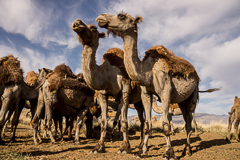Raising Camels

Adult females produce milk, which is used for most of the same things as cow's milk, with at least one notable addition. Areg is milk that is fermented to a sour yogurt or buttermilk taste and a low alcohol content that also produces carbonation—and lots of it when it is kept in a tightly closed bottle. Getting milk from a camel present two problems.
The second problem is milking the camel. An adult camel is a large animal, six to seven feet tall at the shoulder and a foot or two higher than that to the top of its hump or head. It can weigh as much as a small car, and so convincing it to stay still while you milk it is no easy task. Because these camels are waiting to get to their calves, they cluster around the corral without much effort. When milking them most can be convinced to stand still with a rope around their back legs. For difficult or stubborn camels, someone will grab them by their ear and hang on firmly until the milking is done.
The first problem, of course, is keeping young camels from drinking all the milk. To do this, the calves are separated from their mothers during the day and the mothers are milked when they return in the evening, before they are returned to their waiting calves. The act of separating the young from their mothers is done first thing in the morning, and it's not a pretty thing to listen to. This recording was made as the adults are being driven away from the large stone corral where they are kept at night.